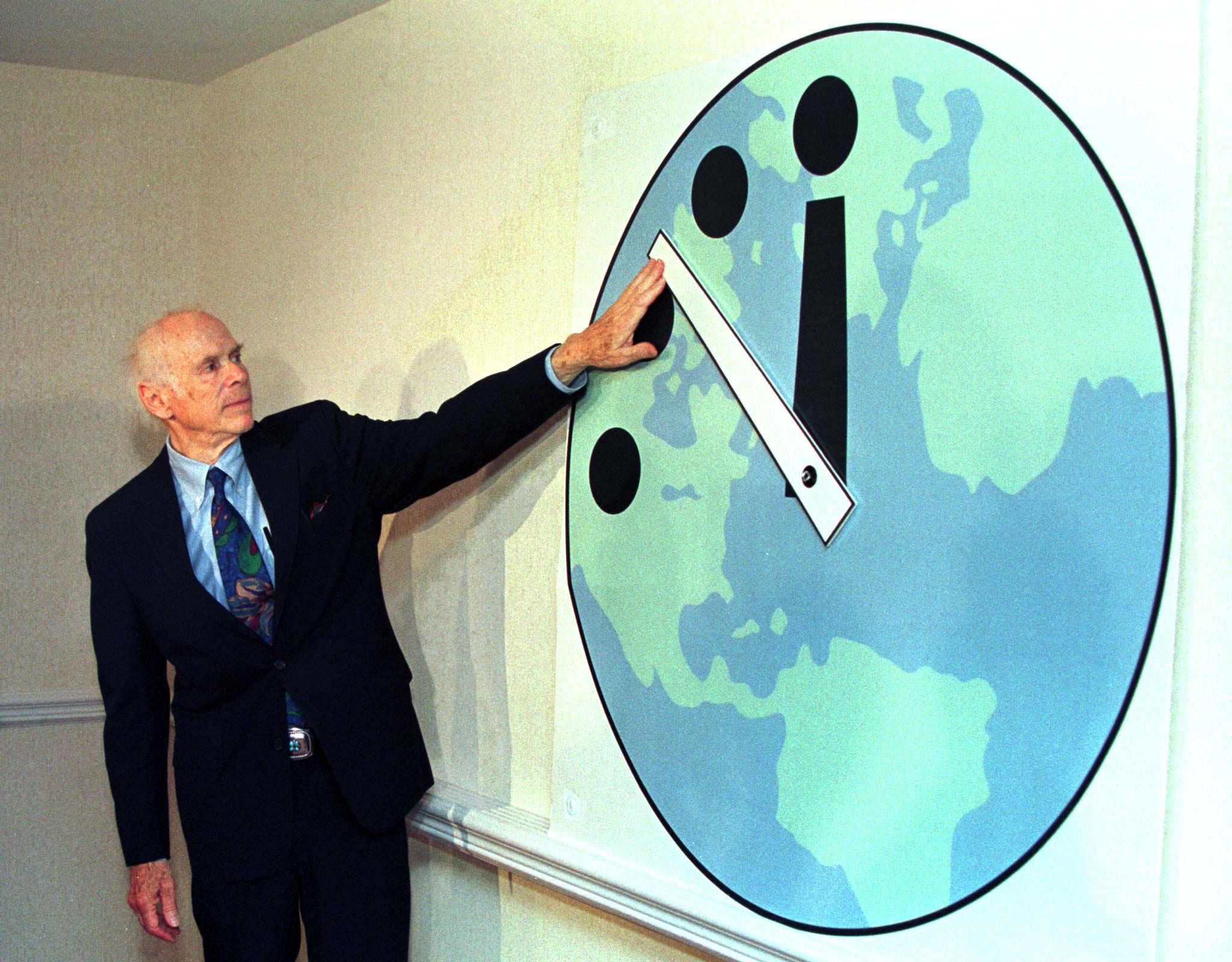
Updated | How close is humanity to destroying itself?
The Bulletin of the Atomic Scientists, a publication that discusses the dangers of nuclear weapons, climate change and other perils that threaten humanity, says we are too close to the edge. Since 1947, the Bulletin has annually updated its famous "doomsday clock," which is meant to measure the likelihood of the various threats that could cause imminent disaster.
On Tuesday, the Bulletin left the clock at "three minutes to midnight," after setting it there in 2015. This is the closest it's been to midnight—midnight being doomsday—since 1983. The publication itself was founded in 1945 by Manhattan Project scientists, who "could not remain aloof to the consequences of their work," according to the group.
"I must say with utter dismay that it stays at three minutes to midnight," said Rachel Bronson, the publication's executive director and publisher in a teleconference Tuesday.
Lawrence Krauss, chair of the group's board of sponsors and professor at Arizona State University, said there has been some progress in the world over the last year, specifically in the Paris agreement, which saw many countries make pledges to reduce greenhouse gas emissions, and in nuclear talks with Iran. But these bright spots notwithstanding, nuclear tensions between the United States and Russia have grown, North Korea is still pursuing and testing atomic weapons, and conflict between India and Pakistan remains high. Moreover, "the fight against climate change has barely begun, and many countries aren't ready to make" the difficult decisions necessary to adequately reduce their emissions, Krauss said.
"The decision not to move the lock is not good news, but a condition of grave concern that the situation remains largely the same," he added.
The Bulletin is also dismayed by the United States' plan to "modernize" its nuclear weapons, which is expected to cost between $100 billion and $1 trillion. Besides being a huge economic drain, "what message does this send to non-nuclear nations about our intents?" Krauss asked.

The publication went on to urge the nations of the world and the United States in particular to spend less on nuclear weapons, make progress toward nuclear disarmament, engage North Korea diplomatically, follow up on the Paris agreements to keep global warming to below a 2 degrees Celsius (3.6 degrees Fahrenheit) rise in temperatures, properly deal with nuclear waste and "create solutions to potentially catastrophic misuses of weapons" technologies.
California Governor Jerry Brown, chiming in on the teleconference, strongly endorsed the group's actions. Brown said we collectively need to "wake up, face the [potential for the] apocalypse and prevent it."
In 2015, the publication set the clock at "three minutes to midnight," a significant move up from its previous position at five minutes till midnight. It made this change because "unchecked climate change, global nuclear weapons modernizations and outsized nuclear weapons arsenals pose extraordinary and undeniable threats to the continued existence of humanity, and world leaders have failed to act with the speed or on the scale required to protect citizens from potential catastrophe," the Bulletin wrote at the time. "These failures of political leadership endanger every person on Earth."
The closest the clock had been to midnight came in 1953, when it was set to 11:58 p.m. That year, the United States decided to pursue the hydrogen bomb, a weapon much more powerful than an atomic bomb.
The clock's least alarming year was in 1991, at the end of the Cold War, when it was set at 17 minutes to midnight. At that time, both the United States and Russia had begun making cuts in their nuclear arsenals, and the Strategic Arms Reduction Treaty had greatly reduced the number of weapons deployed by each country. "The illusion that tens of thousands of nuclear weapons are a guarantor of national security has been stripped away," the Bulletin wrote at the time.
This article has been updated to reflect the Bulletin's announcement Tuesday at 1:30 p.m. ET.
Uncommon Knowledge
Newsweek is committed to challenging conventional wisdom and finding connections in the search for common ground.
Newsweek is committed to challenging conventional wisdom and finding connections in the search for common ground.
About the writer
Douglas Main is a journalist who lives in New York City and whose writing has appeared in the New York ... Read more
To read how Newsweek uses AI as a newsroom tool, Click here.








